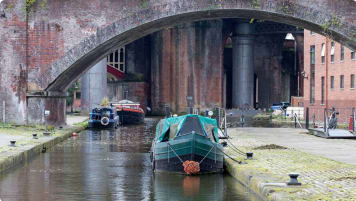Landscapes of Medieval England
Article about Medieval England supporting Britain's history from the Roman's to Queen Victoria and the industrial revolution.
15 Sep 21 · 12 mins read

Landscapes of Medieval England
While human history is portrayed as ever changing, we tend to think of the natural landscape as static and unmoving. In reality, human activity and the land are always entwined, constantly shaping one another as they evolve. We cannot assume that the landscapes of the past are the same as what we see around us today.
This article aims to immerse the reader in the landscapes – town, city, and countryside – of medieval England, with a focus on the 14th century (1300-1400). To do this, we have drawn on Ian Mortimer’s book, The Time Traveller’s Guide to Medieval England.
Mortimer begins his immersive history by vividly setting a typical scene:
Imagine yourself in a dusty London street on a summer morning. A servant opens an upstairs shutter and starts beating a blanket. A dog guarding a traveller’s packhorses starts barking. Nearby traders call out from their market stalls while two women stand chatting, one shielding her eyes from the sun, the other with a basket in her arms. The wooden beams of houses project out over the street. Painted signs above the doors show what is on sale in the shops beneath. (Mortimer, The Time Traveller’s Guide to Medieval England, 1).
This article is part of our series on England and Great Britain, designed to provide background before you go on an England tour with us, or to simply help you firm up your travel plans. Our articles on England can be found here.
Travellers with a particular interest in the Middle Ages might want to take a look at our previous articles on the topic: A Traveller’s Guide to Medieval England, Village Life in Medieval Britain and Understanding British Churches.

The city:
By the standards both of our own time and of the Middle Ages, the cities of medieval England were small. Only the largest – London, with a population of around 40, 000 – could compete with the largest continental cities: Bruges, Ghent, Paris, Venice, Florence and Rome, all of which had populations of over 50, 000. Following London, the ten largest cities in 1377 were:
- York – 12, 100
- Bristol – 10, 600
- Coventry – 8, 000
- Norwich – 6, 600
- Lincoln – 5, 900
- Salisbury – 5, 400
- Lynn – 5, 400
- Colchester – 4, 900
- Boston – 4, 800.
All in all, historians can assume that around 170, 000 people lived in the thirty largest settlements in England. Beyond the biggest cities, there were about two hundred other market towns in England with more than four hundred inhabitants.
In total, about 12% out of a population of 2.5 million English people in 1377 lived in a town of some sort, while 6-7% percent lived in the largest cities.
Small cities dominated Medieval England
The small size of regional cities shouldn’t make you assume that they were sleepy, however. The cities were home to an ever-changing population of travellers – clergymen, merchants, messengers, king’s officers, judges, clerks, master masons, carpenters, pilgrims, painters, itinerant preachers and musicians. Many merchants and traders came from abroad, and foreign accents and languages were commonly heard in most cities. Moreover, while the majority of the population lived in the countryside, they made regular trips to towns and cities, further expanding the temporary population.
Most of all, medieval cities were geographically small, leading to an overwhelming array of human sounds, smells and activities within a confined space. As Mortimer describes:
Arriving [in the city] involves an assault on all the senses. Your eyes will open wide at the great churches, and you will be dazzled by the wealth and the stained glass they contain. Your nostrils will be invaded by the stench from the sewage-polluted watercourses and town ditches […] In any town on a market day, or during a fair, you will find yourself being jostled by the crowds who come in from the country for the occasion, and who live it up rowdily in the taverns. To visit an English town in the late fourteenth century is a bewildering and extreme sensory experience (Mortimer, The Time Traveller’s Guide to Medieval England, 7).
At the heart of most medieval cities was the cathedral. In most cities, it is the tallest building by far – hundreds of times bigger than the buildings that surround it. It is usually the first thing visible when you reach town.
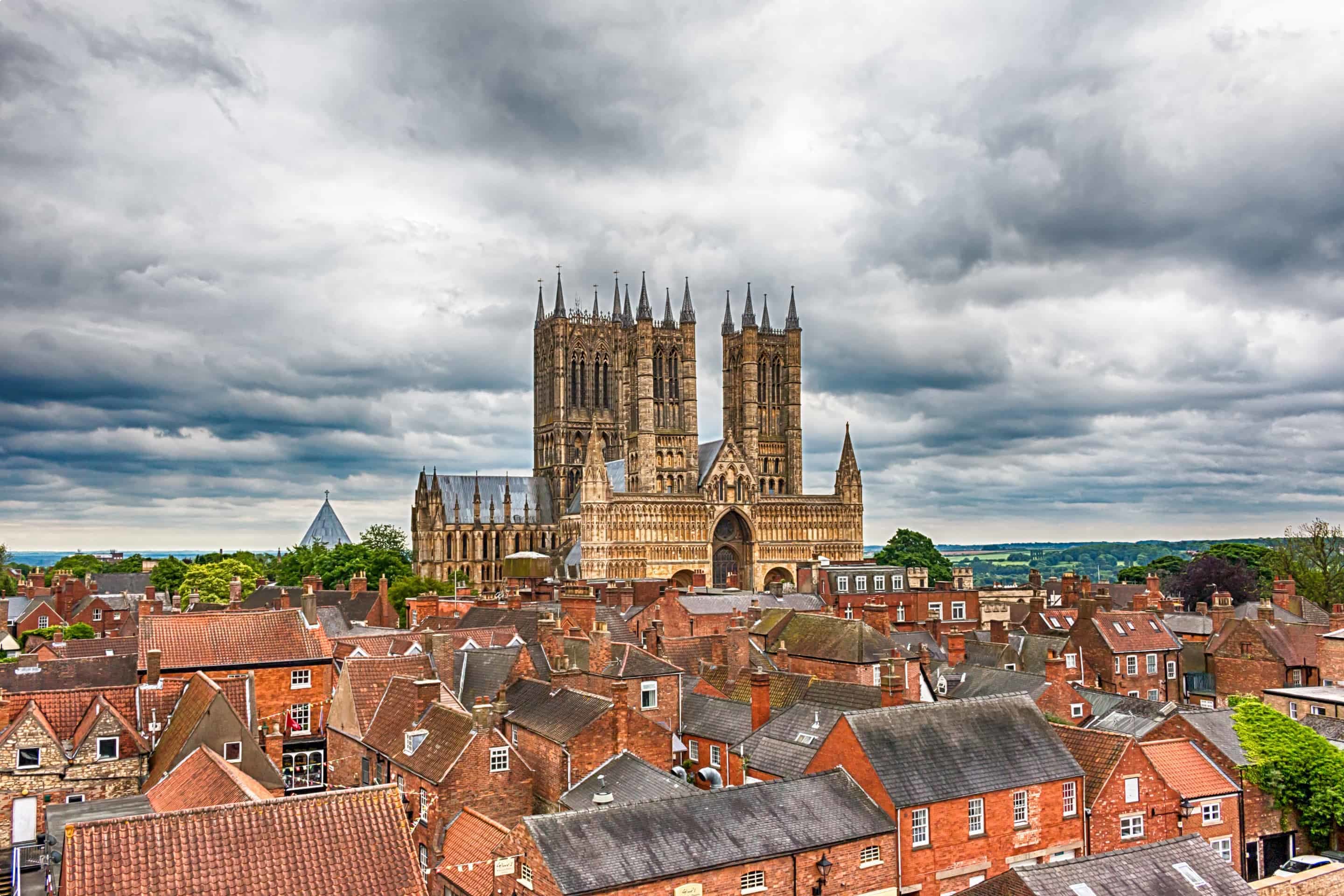
The area surrounding the cathedral was usually enclosed by a wall, letting people in during the daylight hours, and keeping them out after dark. Older monasteries, many of which dated back to the Saxon era, were sometimes located in the centre of the city, and were likewise walled off, as were royal palaces. In most cities, between a third and a half of the area within the city walls was given over to these religious and secular precincts.
The result was that most of the population had to live in only half the city. The finest houses, those of merchants, churchmen, and those in the growing professions, were situated on the widest, grandest, and cleanest streets, usually those between the city gate and the centre of town. While at the start of the 14th century, most of these houses were made of wood, by 1400 they were usually stone structures, with chimneys and glazed windows.
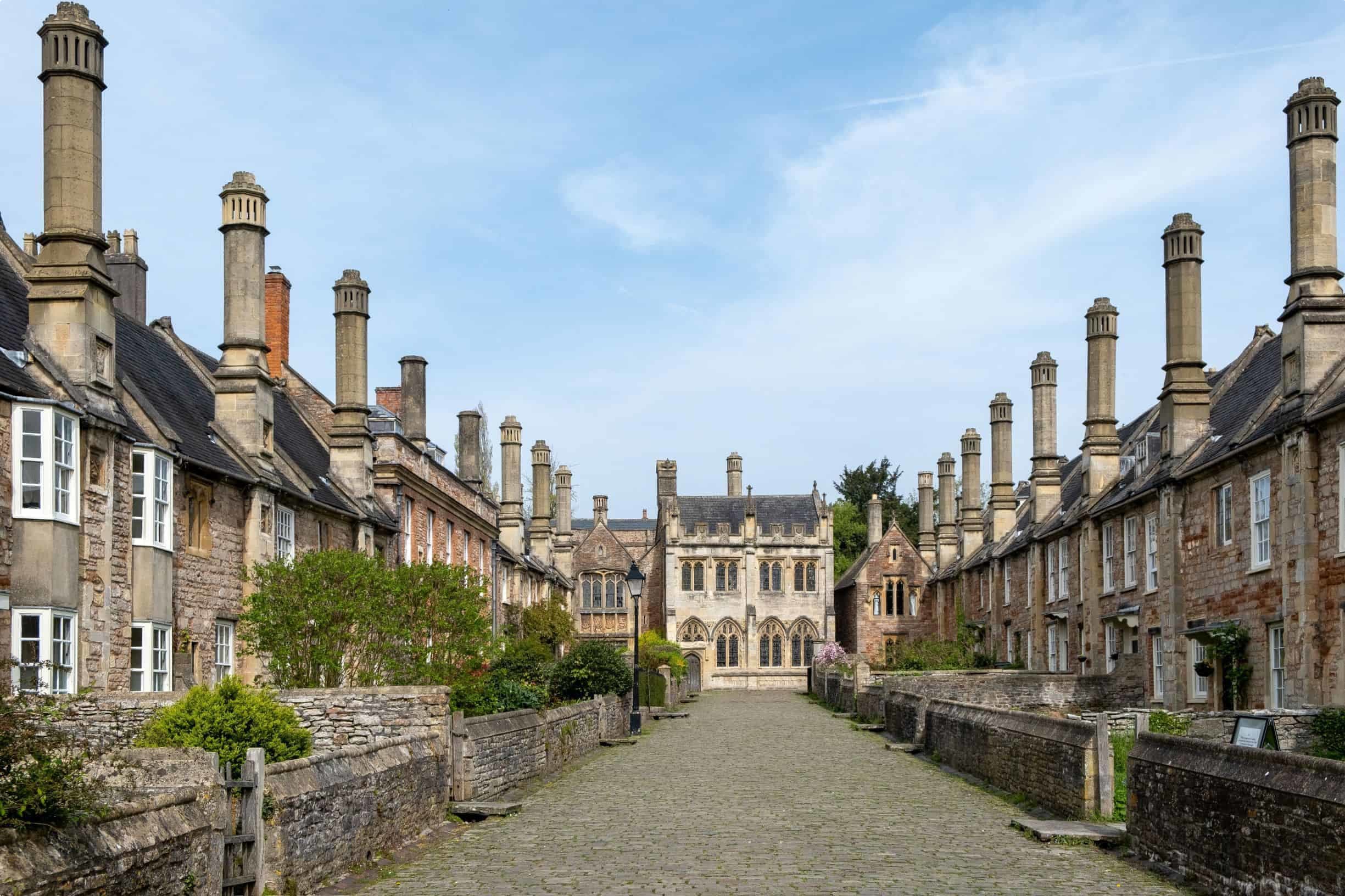
The houses of less successful merchants were more modest. These tended to be narrow and tall, no more than about 15 or 16 feet wide, but three or four stories in height. Merchants purposely built tall and narrow in order to have frontage on the main marketplace, and many operated stores and workshops on the bottom floor of their home. Only the richest merchants had houses separate from their warehouses.
Off the main streets of the city were the more modest houses of the town’s poor. Alleys were often no more than six or seven feet wide. The jetties of the second and third stories are usually within three or four feet from another, blocking the sun from reaching the street below. Some alleys were muddy paths, which, if not cleaned, became dank, smelly and unsavoury – particularly when wet.

The poorest of the poor lived on streets that were narrower still, often only three or four feet wide, in low, single-story terraces of timber buildings, subdivided into small rented rooms. Paths and allies leading to them are little more than drains, ‘effectively open sewers’ (Mortimer, The Time Traveller’s Guide to Medieval England, 12). Most poor families lived in a single room divided into two unequal parts, the smaller for children to sleep in, and the larger for cooking and the adults’ mattresses.
Another notable feature of the medieval city is the total absence of public space. There were no public parks or gardens, and open squares were rare in English cities, except when they served as the marketplace. The street was the only domain of the people. It was there that they heard news, saw performances, and met for large events.
London:
If the standard medieval city was a place of extremes, London was the most extreme of them all: the richest, the most vibrant, the most polluted and the most diverse. Already dominant at the beginning of the 14th century, the next 100 years would see London’s status further enhanced as the city of Westminster became the permanent seat of government in the 1330s.
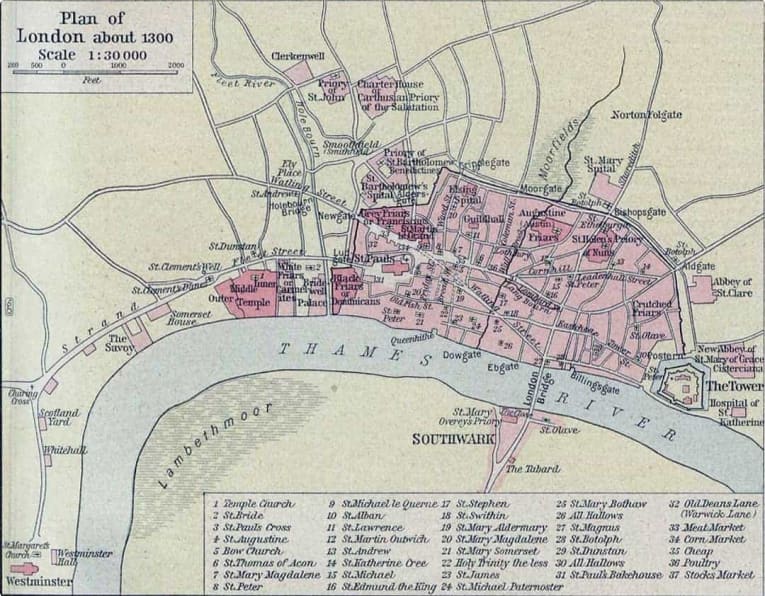
Visitors to London were overwhelmed by the spectacle. The city was home to so many houses, so many shops, so many boats bobbing on the Thames, and so many people – many of whom were dressed in fine velvet, satin and damask. Luxury houses lined the long and elegant strand, joining the city to the adjacent town of Westminster.
Yet, London was also home to extreme filth and poverty. The streets were not paved; there was no sewage system; and rats – harbingers of the 1348-9 plague – were seen everywhere. The city was highly over populated, and slowly grew beyond the town walls. As a major manufacturing centre with a large population, London created an unending stream of rubbish – sewage, rotting carcasses and industrial waste.
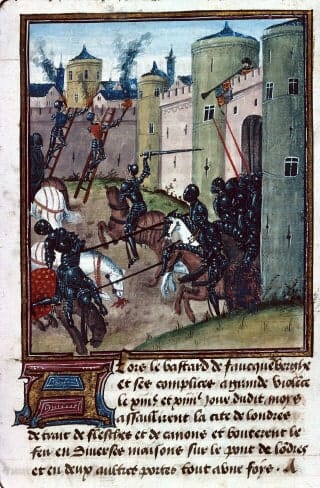
The situation did improve over the 14th century. At the beginning of the century, tanners (the treating of hides and skins to produce leather) could set up shop next to residential houses; and sellers of animal skins and wools were neighbours of spicemongers and apothecaries. In 1309, fines were levelled on those who leave human or animal excrement in the streets. In 1310, tailors and pelterers were forbidden from scouring furs in the main streets. From 1357 it was made illegal to leave dung, crates and empty barrels in the street, and to throw rubbish in the Thames and Fleet rivers. Finally, in 1371, the slaughtering of large beasts within city limits was prohibited.
Nor was it all filth. Medieval London was also home to stunning architecture. Though the medieval city was largely destroyed in the Great Fire of 1666, several important pieces of architecture remain:
The Tower of London:
While the iconic White Tower, built by William the Conqueror, was already an old building in the 14th century, the majority of the tower dates from the 13th century. Highlights include an extensive royal palace, including great hall, private living room, the royal library and the royal menagerie. From the late 1330s the King’s collection of lions, leopards and other big cats is kept here, continually supplemented with new animals.

London Wall:
Like all medieval cities, London was surrounded by a high wall, in order to keep the city safe at night. London’s wall was first built by the Romans in the late 2nd and early 3rd centuries. The walls were repaired and rebuilt through the Middle Ages, though by the late medieval era, the city had expanded well beyond the walls.
Though most of the medieval city was destroyed in the 1666 Great Fire of London, patches of the walls remain. Some of the most impressive fragments date from the Middle Ages, including the Museum of London Tower, built in the 13th century, and Postern Gate, rebuilt in 1440.
Westminster Abbey:
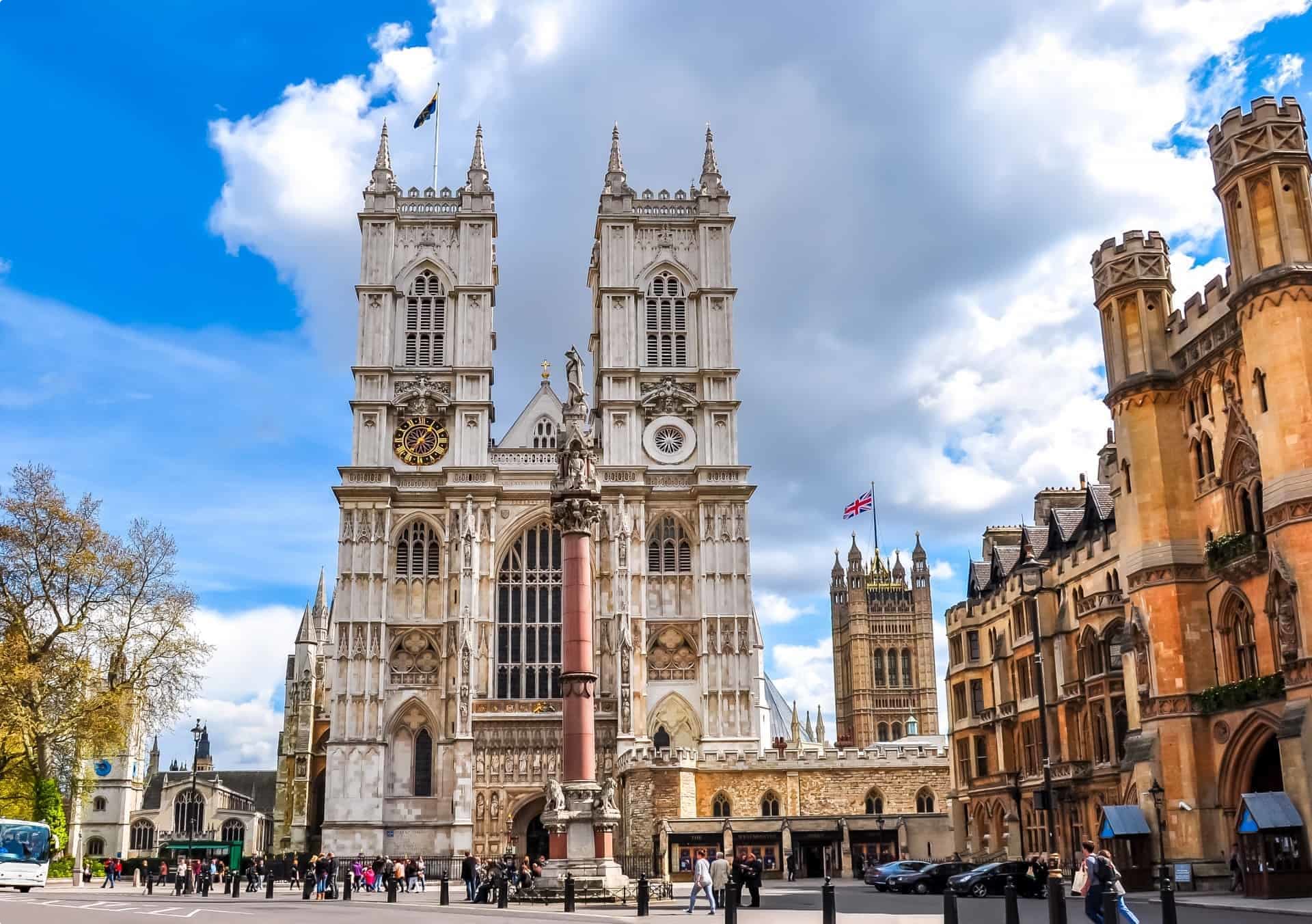
First built by the Anglo-Saxon king Edward the Confessor in from 1040-1050, the church was the first in England to be built in a Romanesque style. The Abbey was almost entirely rebuilt by Henry III in the thirteenth century at a cost of more than 41,000 pounds – making it the second-most expensive building in the whole of medieval England (second only to Edward III’s work at Windsor Castle). In the Middle Ages, Westminster Abbey was covered in magnificent wall paintings, sadly gone today.
St Olave’s Church:
This church was constructed around the 1250s, and is one of only few churches from the Middle Ages to have survived the 1666 Great Fire. It is one of the smallest churches in London.

Charterhouse:
These buildings were used in the 14th century as a burial ground for victims of the Great Plague. The Charterhouse was subsequently used as a priory, a boy’s school and an alms-house. Though most of the buildings were rebuilt in the 16th century, there are still substantial remains from the Middle Ages.
Cloth Fair:
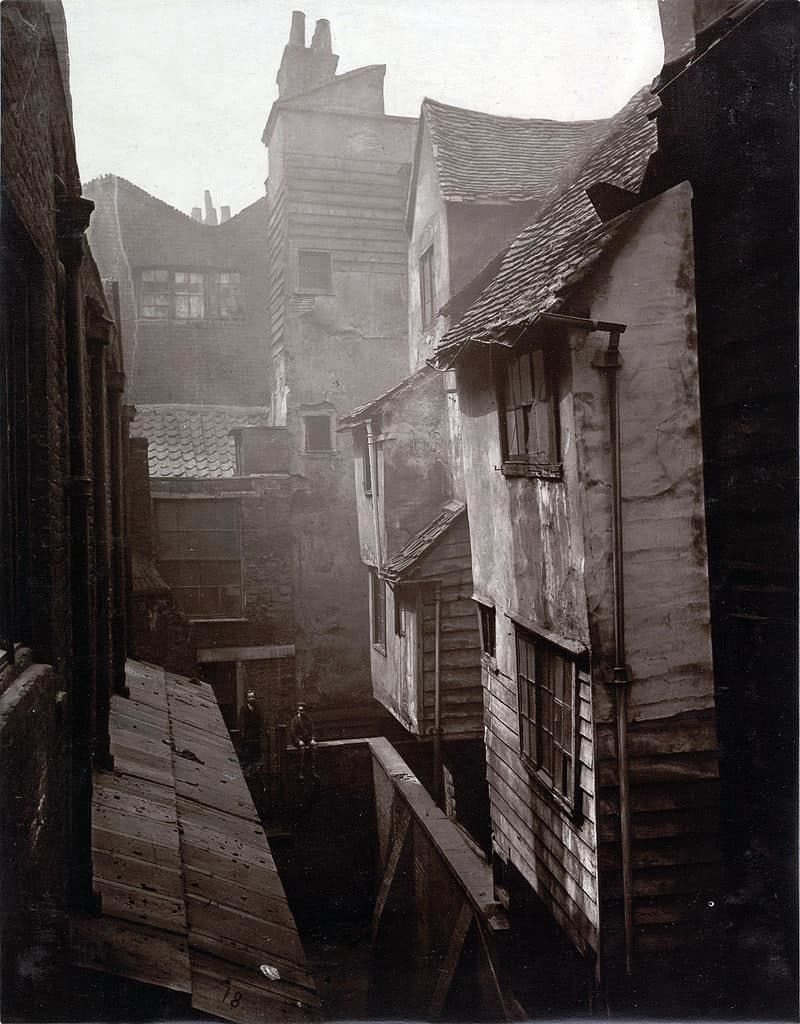
The name of this medieval street comes from its original use as the place where medieval merchants bought and sold cloth during St. Bartholomew’s Fair. Because the houses were within the walls of St. Bartholomew’s Church, they survived the Great Fire of 1666. Though most of the medieval buildings were torn down in slum clearance after World War I, the oldest residential house in London, built between 1597 and 1611, can be found here.
The Church of St. Bartholomew the Great:
This church is a good example of Norman, or Romanesque, architecture. Founded as a priory in 1123, the medieval nave was pulled down in the 1500s. Some parts dating to the Middle Ages remain, including the crossing (the junction were the four arms of a cross-shaped church meet), and the choir (the area between the nave and the sanctuary). In the 18th century, Benjamin Franklin – one of the US’s founding fathers – worked here as a typesetter, while the church was a location in the movie Four Weddings and a Funeral.

Small towns and villages
Most small towns had populations of around five hundred – three or four streets, about a hundred houses, and some stables. Today, most people would probably think of a settlement of that size as a village – but in the Middle Ages, town status was granted to any settlement with a market.
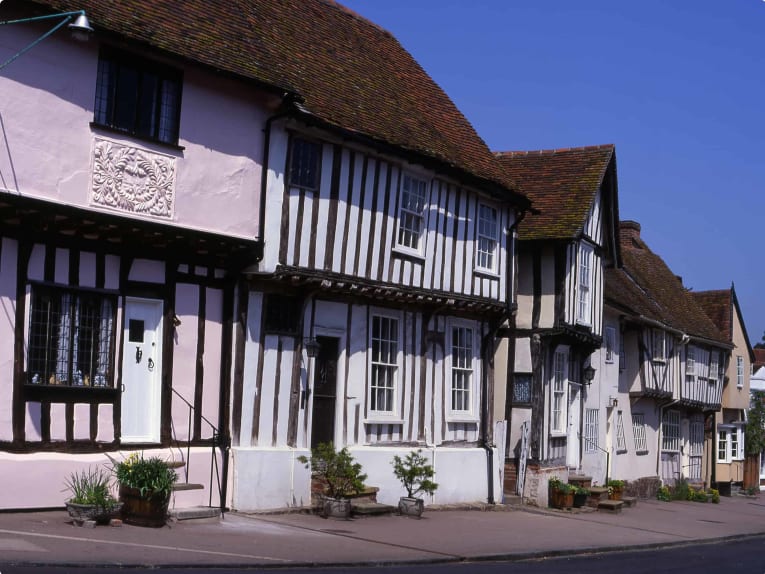
A town with a market had importance far beyond its small population. It served a large rural hinterland. Farmers came to buy plowshares, and sell their livestock and grain. They and their wives needed to buy cookware, salt, candles, needles, leather goods and other items. Even well-off people on remote manors needed to head to town (or send a servant) to pick up necessary goods such as nails and other tools.
By 1300, almost nowhere in England was more than eight miles from a market town. Unlike the cities, market towns did not have high walls to protect the city. They tended to be gathered around the marketplace. Other principal structures were the church, the manor house, the vicarage, and the inns. There was no guildhall, or monastery or friary.

The streets would be muddy and uneven, and like in the cities, filthy. The marketplace was probably full of little wooden stalls, lived above by the traders. There were none of the ordinances found in the cities that prevented unsanitary trades from being carried out.
On market day, the scene was different. There was a palpable energy: a huge crowd from the surrounding districts, as well as travellers from other parts of England and abroad. Music was heard in the streets, and the ale houses were full of people laughing and enjoying themselves.
Even smaller than the towns were villages, medieval settlements without a market. These had little order in layout or presentation. Houses were generally made of limewashed cob and had broad thatched roofs.
The countryside
By the 14th century, most of rural England was under human control. Around seven percent of the land was woodland, not much more than today’s Britain. The woods were managed carefully by people. Some sections were cleared for timber, while the right to gather sticks and fallen timber was often granted to tenants by the manorial lord.
Yet, the trees in medieval England were very different from those seen today. There were few coniferous species – these would be subsequently grown. The absence of evergreens meant that the winter skyline was particularly bleak. The trees were largely those introduced by the Romans, mingled with regrowth dating back to the Ice Ages: rowan, ash, field maple, hazel, chestnut, aspen, poplars, birch, willow, elm and oak.
The animals, too, were different. All the squirrels were red – the grey variety had not yet reached Britain. Cows, sheep, and other farm animals were much smaller than their modern counterparts.
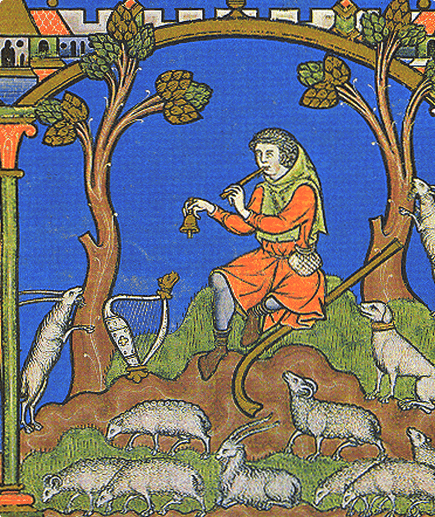
The 14th century saw substantial changes in climate: the average temperature dropped by about one degree centigrade. While this might not seem like a huge drop, it had significant ramifications: while England had a small wine industry in 1300, by 1400 this was destroyed. The colder climate meant greater rainfall, which flooded roads and ruined crops.
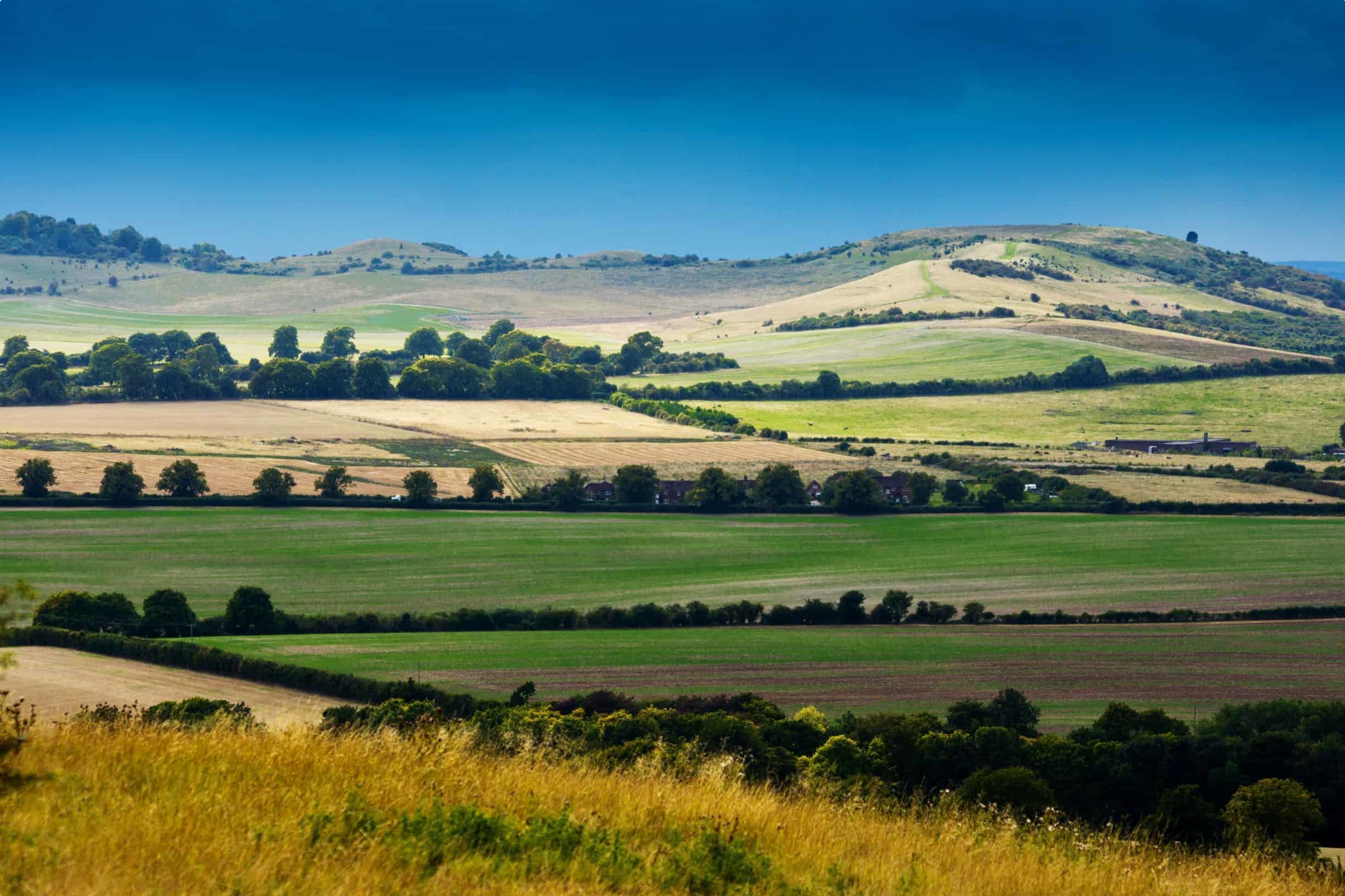
The way that the land was used for agriculture differed, too. While modern English fields tend to be small, square and even, in the fourteenth century most fields were massive and irregularly shaped, enclosed by dry stone walls. They were then divided into individual strips of land, maintained separately by each tenant. Prior to the development of crop rotation, every third strip of land would have been left fallow, grazed in the meantime by cattle, sheep, goats or pigs.
Around these huge areas of land were the commons: collectively owned land (or land where tenants were able to exercise traditional rights of usage) that peasants used to graze sheep and grow hay, or woodlands used to provide firewood and building materials.
The population density of rural areas varied considerably across England. The most densely populated areas were in the lowland regions of East Anglia. The highest population density in England in 1377 was in Bedfordshire, with a population of 73 people per square mile.
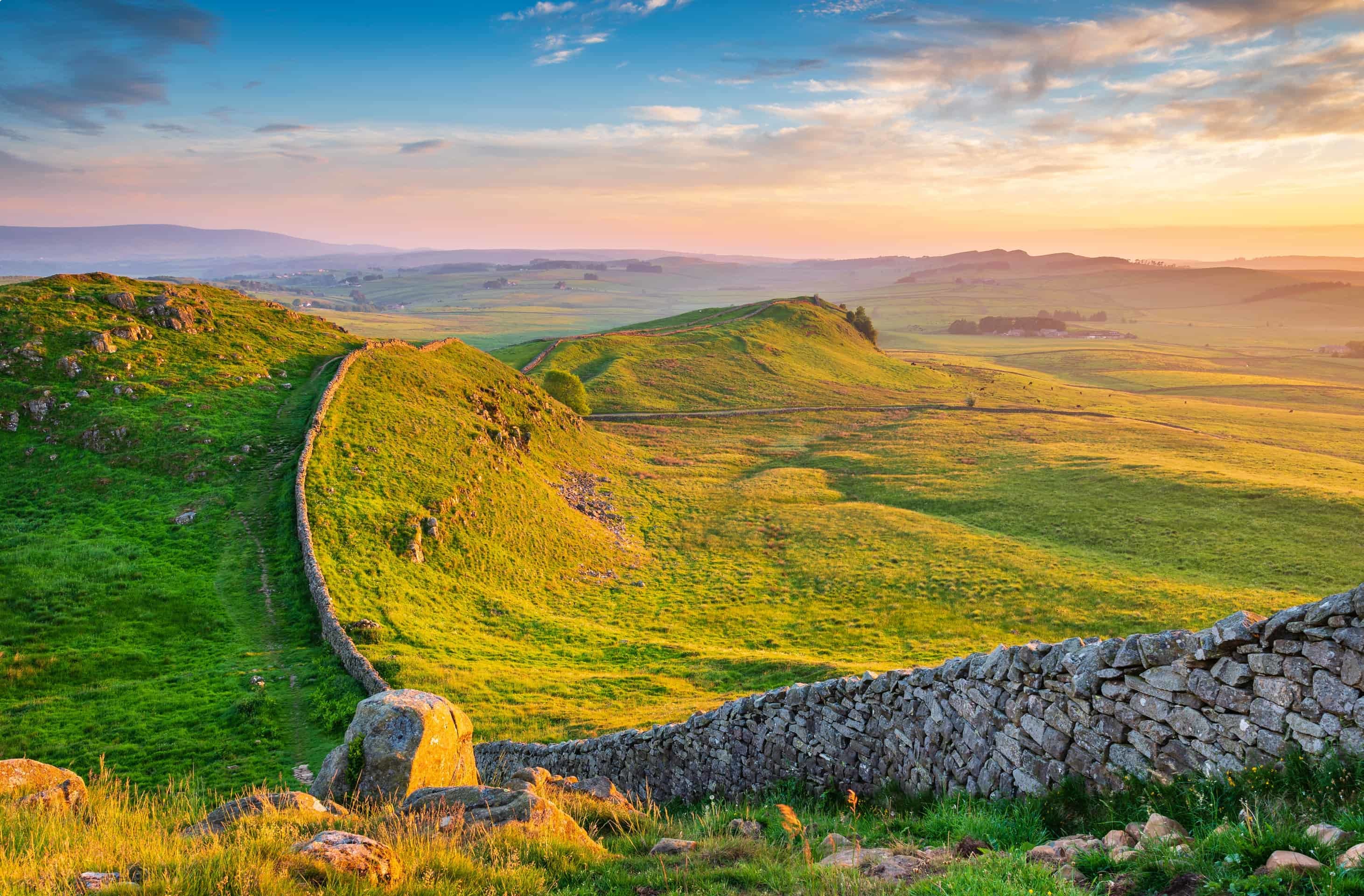
By contrast, hilly regions had a much lower (and poorer) population. Many settlements in these regions were abandoned after the Great Plague. The largest areas of abandoned landscape were found in the North, particularly in the Scottish-border counties of Cumberland and Northumberland. In 1377, Cumberland had a population density of 13 per square mile, but this statistic does not clearly evoke the swathes of territory totally deserted due to Scottish incursions.
If this article has interested you in learning more about the medieval history of England, think about joining our small group tour of Medieval England. This tour is one among many devoted to the history and culture of England – take a look at the full list.
You might also be interested in our summer school devoted to Medieval and Renaissance Women.
Related Tours
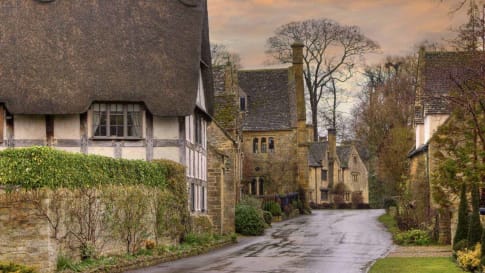
19 days
Jun, SepEngland’s villages small group history tours for mature travellers
Visiting England
Guided tour of the villages of England. The tour leader manages local guides to share their knowledge to give an authentic experience across England. This trip includes the UNESCO World heritage site of Avebury as well as villages in Cornwall, Devon, Dartmoor the border of Wales and the Cotswolds.
From A$16,995 AUD
View Tour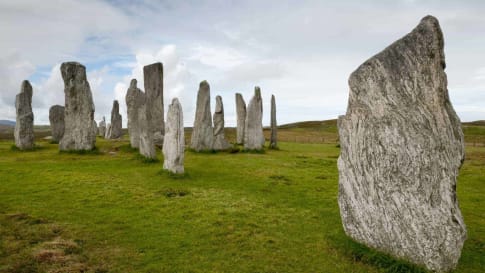
21 days
AugPrehistoric Britain small group history tour including standing stones
Visiting England, Scotland
This guided tour invites you to explore UNESCO World heritage sites at Skara Brae in the Orkneys, Isle of Skye, and Stonehenge in a prehistoric tour. This escorted tour has trips to key sites in Scotland, and the Irish sea in Wales such as Gower Peninsula and National Museum in Cardiff and England. Each day tour is supported by local guides.
From A$16,750 AUD
View Tour
22 days
Sep, JunRural Britain | Walking Small Group Tour
Visiting England, Scotland
A walking tour into England, Scotland and Wales provides small group journeys with breathtaking scenery to destinations such as Snowdonia national park , the UNESCO world heritage site Hadrians wall and the lake district. each day tour provides authentic experiences often off the beaten path from our local guides.
From A$16,675 AUD
View Tour
22 days
Apr, SepSmall group tours Medieval England
Visiting England
A small group tour of England focused on Medieval England and Wales. Spend 21 days on this escorted tour with tour director and local guides travelling from Canterbury to Cambridge, passing through Winchester, Salisbury, Bristol, Hereford and Norwich along the way. Castles, villages, Cathedrals and churches all feature in the Medieval landscapes visited.
From A$15,395 AUD
View Tour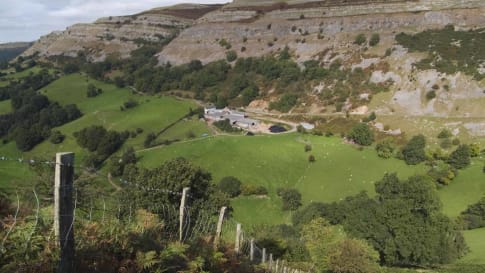
20 days
May, Sep, JunWalking Ancient Britain
Visiting England
A walking tour of England & the border of Wales. Explore on foot UNESCO World Heritage sites, Neolithic, Bronze age and Roman landscapes and the occasional Norman castle on your journey. Your tour director and tour guide walk you through the Brecon beacons, the Cotswolds and Welsh borders on this small group tour.
From A$14,725 AUD
View TourRelated Articles

Discovering Medieval Chester: A Thriving Trade Centre
Article about Chester, England for small group educational tours for senior couple and mature solo travellers to England. Articles to support your travel plans to explore England, Scotland, Wales and Ireland.

English Village History
An English Village history. Prepared for mature and senior travellers, couples or solo traveller considering joining a small group tour of England's villages.
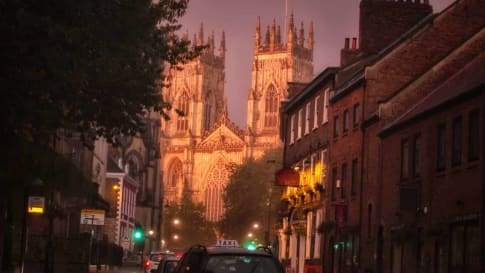
Exploring York
Article about York, England. Explored on a small group educational tour for senior couples and mature singles curious about history from the Romans, the Vikings and the industrial revolution. Including the famous York Minster a great cathedral!

Lumps and Bumps: How to Read the British Landscape
The British landscape has been worked and re-worked. It is secrets of this palimpsest landscape is revealed through drainage patterns and prehistoric features all the way through to the modern day. These small group tours for mature and senior travellers examine the landscape from the Neolithic, to Roman, through the seven ages of Britain in walking tours and history tours of Britain.
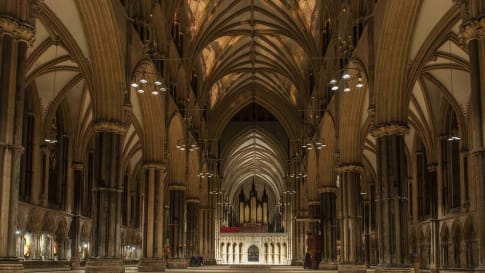
Traveller's Guide to Medieval England
A travellers guide beyond the landscapes of Medieval England supporting Britain's history from the Roman's to Queen Victoria and the industrial revolution.

Understanding British Churches: The Definitive Guide for Travellers
British Churches Through the Years “How old is this church?” asks Mary-Ann Ochota in a chapter of her book, Hidden Histories: A Spotter’s Guide to the British Landscape (Francis Lincoln, 2016, p. 250). In this article, we…


